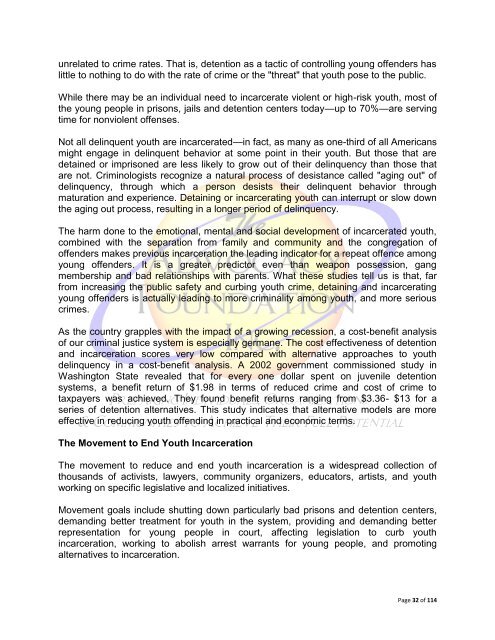African-American Youth in The Juvenile Justice System
African-American Youth in The Juvenile Justice System
African-American Youth in The Juvenile Justice System
Create successful ePaper yourself
Turn your PDF publications into a flip-book with our unique Google optimized e-Paper software.
unrelated to crime rates. That is, detention as a tactic of controll<strong>in</strong>g young offenders has<br />
little to noth<strong>in</strong>g to do with the rate of crime or the "threat" that youth pose to the public.<br />
While there may be an <strong>in</strong>dividual need to <strong>in</strong>carcerate violent or high-risk youth, most of<br />
the young people <strong>in</strong> prisons, jails and detention centers today—up to 70%—are serv<strong>in</strong>g<br />
time for nonviolent offenses.<br />
Not all del<strong>in</strong>quent youth are <strong>in</strong>carcerated—<strong>in</strong> fact, as many as one-third of all <strong>American</strong>s<br />
might engage <strong>in</strong> del<strong>in</strong>quent behavior at some po<strong>in</strong>t <strong>in</strong> their youth. But those that are<br />
deta<strong>in</strong>ed or imprisoned are less likely to grow out of their del<strong>in</strong>quency than those that<br />
are not. Crim<strong>in</strong>ologists recognize a natural process of desistance called "ag<strong>in</strong>g out" of<br />
del<strong>in</strong>quency, through which a person desists their del<strong>in</strong>quent behavior through<br />
maturation and experience. Deta<strong>in</strong><strong>in</strong>g or <strong>in</strong>carcerat<strong>in</strong>g youth can <strong>in</strong>terrupt or slow down<br />
the ag<strong>in</strong>g out process, result<strong>in</strong>g <strong>in</strong> a longer period of del<strong>in</strong>quency.<br />
<strong>The</strong> harm done to the emotional, mental and social development of <strong>in</strong>carcerated youth,<br />
comb<strong>in</strong>ed with the separation from family and community and the congregation of<br />
offenders makes previous <strong>in</strong>carceration the lead<strong>in</strong>g <strong>in</strong>dicator for a repeat offence among<br />
young offenders. It is a greater predictor even than weapon possession, gang<br />
membership and bad relationships with parents. What these studies tell us is that, far<br />
from <strong>in</strong>creas<strong>in</strong>g the public safety and curb<strong>in</strong>g youth crime, deta<strong>in</strong><strong>in</strong>g and <strong>in</strong>carcerat<strong>in</strong>g<br />
young offenders is actually lead<strong>in</strong>g to more crim<strong>in</strong>ality among youth, and more serious<br />
crimes.<br />
As the country grapples with the impact of a grow<strong>in</strong>g recession, a cost-benefit analysis<br />
of our crim<strong>in</strong>al justice system is especially germane. <strong>The</strong> cost effectiveness of detention<br />
and <strong>in</strong>carceration scores very low compared with alternative approaches to youth<br />
del<strong>in</strong>quency <strong>in</strong> a cost-benefit analysis. A 2002 government commissioned study <strong>in</strong><br />
Wash<strong>in</strong>gton State revealed that for every one dollar spent on juvenile detention<br />
systems, a benefit return of $1.98 <strong>in</strong> terms of reduced crime and cost of crime to<br />
taxpayers was achieved. <strong>The</strong>y found benefit returns rang<strong>in</strong>g from $3.36- $13 for a<br />
series of detention alternatives. This study <strong>in</strong>dicates that alternative models are more<br />
effective <strong>in</strong> reduc<strong>in</strong>g youth offend<strong>in</strong>g <strong>in</strong> practical and economic terms.<br />
<strong>The</strong> Movement to End <strong>Youth</strong> Incarceration<br />
<strong>The</strong> movement to reduce and end youth <strong>in</strong>carceration is a widespread collection of<br />
thousands of activists, lawyers, community organizers, educators, artists, and youth<br />
work<strong>in</strong>g on specific legislative and localized <strong>in</strong>itiatives.<br />
Movement goals <strong>in</strong>clude shutt<strong>in</strong>g down particularly bad prisons and detention centers,<br />
demand<strong>in</strong>g better treatment for youth <strong>in</strong> the system, provid<strong>in</strong>g and demand<strong>in</strong>g better<br />
representation for young people <strong>in</strong> court, affect<strong>in</strong>g legislation to curb youth<br />
<strong>in</strong>carceration, work<strong>in</strong>g to abolish arrest warrants for young people, and promot<strong>in</strong>g<br />
alternatives to <strong>in</strong>carceration.<br />
Page 32 of 114

















